Underfrequency Load Shedding: An Innovative Algorithm Based on Fuzzy Logic
Abstract
1. Introduction
- total number of shedding thresholds and the frequency values at each threshold; and
- values of power to be switched off at each threshold.
2. General Idea of the Proposed Approach
3. Implementation
3.1. Fuzzification
3.2. Inference
3.3. Defuzzification
3.4. Frequency Thresholds
3.5. Maximum Number of Shedding Stages
- Five different structures of turbine controllers used in the Polish Power System;
- A variety frequency- and voltage-dependent characteristic of loads;
- Fifteen different operating points of the grid, including different initial loads Pg(t = 0) and power imbalances; and
- Different numbers of thresholds Nsh ranging from six to 72.
3.6. Selection of the Amounts of Power to Be Disconnected
4. Validation of the Proposed Algorithm
- rated load of generator Pg(t=0) = Pgr and ΔP = 0.41;
- rated load of generator Pg(t=0) = Pgr and ΔP = 0.15;
- generator operation with a power equal to the technical minimum Pg(t=0) = Pgmin and ΔP = 0.25;
- generator operation with a power equal to the technical minimum Pg(t=0) = Pgmin and ΔP = 0.05;
- disconnection failure at the first stage threshold, meaning Psh(1) = 0 (the corresponding plots are labeled “w/o Psh(1)“ in Figure 10);
- disconnection failure at the fourth stage threshold, meaning Psh(4) = 0 (the corresponding plots are labeled “w/o Psh(4) “ in Figure 10); and
- disconnection failures at the first and fourth stage thresholds, meaning Psh(1) = 0 and Psh(4) = 0 (the corresponding plots are labeled “w/o Psh(1 and 4)“ in Figure 10).
5. Conclusions
- high effectiveness in the case of large disturbances; and
- reduced disconnected power in the case of small and medium disturbances.
Author Contributions
Funding
Conflicts of Interest
References
- Potel, B.; Debusschere, V.; Cadoux, F.; de Alvaro Garcia, L. Under-frequency load shedding schemes characteristics and performance criteria. In Proceedings of the 2017 IEEE Manchester PowerTech, Manchester, UK, 18–22 June 2017; pp. 1–6. [Google Scholar]
- ENTSO-E. Network Code on Emergency and Restoration; ENTSO-E: Brussels, Belgium, 2015. [Google Scholar]
- Sub Group “System Protection and Dynamics” Under Regional Group Continental Europe. Technical Background and Recommendations for Defence Plans in the Continental Europe Synchronous Area; ENTSO-E: Brussels, Belgium, October 2010. [Google Scholar]
- Ceja-Gomez, F.; Qadri, S.; Galiana, F. Under-frequency load shedding via integer programming. IEEE Trans. Power Syst. 2012, 27, 1387–1394. [Google Scholar] [CrossRef]
- Yang, D.Y.; Cai, G.W.; Jiang, Y.T.; Liu, C. Centralized adaptive under frequency load shedding schemes for smart grid using synchronous phase measurement unit. J. Electr. Eng. Technol. 2013, 8, 446–452. [Google Scholar] [CrossRef]
- Seyedi, H.; Sanaye-Pasand, M. New centralised adaptive loadshedding algorithms to mitigate power system blackouts. IET Gener. Transm. Distrib. 2009, 3, 99–114. [Google Scholar] [CrossRef]
- Powell, C.; Bahadoorsingh, S.; Singh, A.; Sharma, C. An adaptive under frequency load shedding scheme for a small island power system. In Proceedings of the 2016 IEEE/PES Transmission and Distribution Conference and Exposition (T&D), Dallas, TX, USA, 3–5 May 2016; pp. 1–5. [Google Scholar]
- Zin, A.A.M.; Hafiz, H.M.; Wong, W.K. Static and dynamic under-frequency load shedding: A comparison. In Proceedings of the International Conference on Power System Technology, Singapore, 21–24 November 2004; pp. 941–945. [Google Scholar]
- Mollah, K.U.Z.; Bahadornejad, M.; Nair, N.K. Automatic under-frequency load shedding in New Zealand power system—A systematic review. In Proceedings of the Universities Power Engineering Conference (AUPEC 2011), Brisbane, QLD, Australia, 25–28 September 2011; pp. 1–7. [Google Scholar]
- Terzija, V.V. Adaptive underfrequency load shedding based on the magnitude of the disturbance estimation. IEEE Trans. Power Syst. 2006, 21, 1260–1266. [Google Scholar] [CrossRef]
- Rudez, U.; Mihalic, R. Monitoring the first frequency derivative to improve adaptive underfrequency load-shedding schemes. IEEE Trans. Power Syst. 2011, 26, 839–846. [Google Scholar] [CrossRef]
- Pasand, M.S.; Seyedi, H. New Centralized Adaptive Under Frequency Load Shedding Algorithms. In Proceedings of the 2007 Large Engineering Systems Conference on Power Engineering, Montreal, QC, Canada, 10–12 October 2007; pp. 44–48. [Google Scholar]
- Wang, Q.; Tang, Y.; Li, F.; Li, M.; Li, Y.; Ni, M. Coordinated Scheme of Under-Frequency Load Shedding with Intelligent Appliances in a Cyber Physical Power System. Energies 2016, 9, 630. [Google Scholar] [CrossRef]
- Dreidy, M.; Mokhlis, H.; Mekhilef, S. Application of Meta-Heuristic Techniques for Optimal Load Shedding in Islanded Distribution Network with High Penetration of Solar PV Generation. Energies 2017, 10, 150. [Google Scholar] [CrossRef]
- Jallad, J.; Mekhilef, S.; Mokhlis, H.; Laghari, J.; Badran, O. Application of Hybrid Meta-Heuristic Techniques for Optimal Load Shedding Planning and Operation in an Islanded Distribution Network Integrated with Distributed Generation. Energies 2018, 11, 1134. [Google Scholar] [CrossRef]
- Li, S.; Tang, F.; Shao, Y.; Liao, Q. Adaptive Under-Frequency Load Shedding Scheme in System Integrated with High Wind Power Penetration: Impacts and Improvements. Energies 2017, 10, 1331. [Google Scholar] [CrossRef]
- Niro, G.; Salles, D.; Alcântara, M.V.P.; da Silva, L.C.P. Largescale control of domestic refrigerators for demand peak reduction in distribution systems. Electr. Power Syst. Res. 2013, 100, 34–42. [Google Scholar] [CrossRef]
- Anderson, P.M.; Mirheydar, M. An adaptive method for setting underfrequency load shedding relays. IEEE Trans. Power Syst. 1992, 7, 647–655. [Google Scholar] [CrossRef]
- Thompson, J.G.; Fox, B. Adaptive load shedding for isolated power systems. IEE Proc. Gener. Transm. Distrib. 1994, 141, 491–496. [Google Scholar] [CrossRef]
- Hoseinzadeh, B.; da Silva, F.F.; Bak, C.L. Power system stability using decentralized under frequency and voltage load shedding. In Proceedings of the 2014 IEEE PES General Meeting | Conference & Exposition, National Harbor, MD, USA, 27–31 July 2014; pp. 1–5. [Google Scholar]
- Albrecht, M.; Robitzky, L.; Rehtanz, C. Selective and decentralized underfrequency protection schemes in the distribution grid. In Proceedings of the 2017 IEEE Manchester PowerTech, Manchester, UK, 18–22 June 2017; pp. 1–6. [Google Scholar]
- Gu, W.; Liu, W.; Zhu, J.; Zhao, B.; Wu, Z.; Luo, Z.; Yu, J. Adaptive Decentralized Under-Frequency Load Shedding for Islanded Smart Distribution Networks. IEEE Trans. Sustain. Energy 2014, 5, 886–895. [Google Scholar] [CrossRef]
- Shariati, O.; Zin, A.A.M.; Khairuddin, A.; Pesaran, M.H.A.; Aghamohammadi, M.R. An Integrated Method for under Frequency Load Shedding Based on Hybrid Intelligent System-Part I: Dynamic Simulation. In Proceedings of the 2012 Asia-Pacific Power and Energy Engineering Conference, Shanghai, China, 27–29 March 2012; pp. 1–6. [Google Scholar]
- Shariati, O.; Zin, A.A.M.; Khairuddin, A.; Pesaran, M.H.A.; Aghamohammadi, M.R. An Integrated Method for under Frequency Load Shedding Based on Hybrid Intelligent System-Part II: UFLS Design. In Proceedings of the 2012 Asia-Pacific Power and Energy Engineering Conference, Shanghai, China, 27–29 March 2012; pp. 1–9. [Google Scholar]
- Seethalekshmi, K.; Singh, S.N.; Srivastava, S.C. A synchrophasor assisted frequency and voltage stability based load shedding scheme for self-healing of power system. IEEE Trans. Smart Grid 2011, 2, 221–230. [Google Scholar] [CrossRef]
- Li, S.; Liao, Q.; Wang, J. Dynamic optimization of adaptive under-frequency load shedding based on WAMS. In Proceedings of the 2016 IEEE Information Technology, Networking, Electronic and Automation Control Conference, Chongqing, China, 20–22 May 2016; pp. 920–926. [Google Scholar]
- Shams, N.; Wall, P.; Terzija, V. Adaptive under frequency load shedding scheme based on dynamic security assessment. In Proceedings of the IET International Conference on Resilience of Transmission and Distribution Networks (RTDN) 2015, Birmingham, UK, 22–24 September 2015; pp. 1–6. [Google Scholar]
- Larsson, M.; Rehtanz, C. Predictive frequency stability control based on wide-area phasor measurements. In Proceedings of the IEEE Power Engineering Society Summer Meeting, Chicago, IL, USA, 21–25 July 2002; pp. 233–238. [Google Scholar]
- Pulendran, S.; Tate, J.E. Energy Storage System Control for Prevention of Transient Under-Frequency Load Shedding. IEEE Trans. Smart Grid 2017, 8, 927–936. [Google Scholar]
- Delille, G.; Francois, B.; Malarange, G. Dynamic frequency control support by energy storage to reduce the impact of wind and solar generation on isolated power system’s inertia. IEEE Trans. Sustain. Energy 2012, 3, 931–939. [Google Scholar] [CrossRef]
- Zhang, L.; Liu, Y.; Crow, M. Coordination of UFLS and UFGC by application of D-SMES. In Proceedings of the IEEE Power Engineering Society General Meeting, San Francisco, CA, USA, 16 June 2005; pp. 1064–1070. [Google Scholar]
- Hsu, C.-T. Enhancement of transient stability of an industrial cogeneration system with superconducting magnetic energy storage unit. IEEE Trans. Energy Convers. 2002, 17, 445–452. [Google Scholar] [CrossRef]
- Thalassinakis, E.J.; Dialynas, E.N.; Agoris, D. Method Combining ANNs and Monte Carlo Simulation for the Selection of the Load Shedding Protection Strategies in Autonomous Power Systems. IEEE Trans. Power Syst. 2006, 21, 1574–1582. [Google Scholar] [CrossRef]
- Bai, D.; Kirby, B.; He, J.; Writer, D.; Yang, X.; Liu, L. Under frequency load shedding scheme based on information sharing technology. In Proceedings of the 22nd International Conference and Exhibition on Electricity Distribution (CIRED 2013), Stockholm, Sweden, 10–13 June 2013; pp. 1–4. [Google Scholar]
- Abdel-Rahman, K.; Mill, L.; Phadke, A.; de la Ree, J.; Liu, Y. Internet based wide area information sharing and its roles in power system state estimation. In Proceedings of the 2001 IEEE Power Engineering Society Winter Meeting, Columbus, OH, USA, 28 January–1 February 2001; Volume 2, pp. 470–475. [Google Scholar]
- Nirenberg, S.A.; McInnis, D.A.; Sparks, K.D. Fast acting load shedding. IEEE Trans. Power Syst. 1992, 7, 873–877. [Google Scholar] [CrossRef]
- Parniani, M.; Nasri, A. SCADA based under frequency load shedding integrated with rate of frequency decline. In Proceedings of the 2006 IEEE Power Engineering Society General Meeting, Montreal, QC, Canada, 18–22 June 2006; p. 6. [Google Scholar]
- Lu, N. An Evaluation of the HVAC Load Potential for Providing Load Balancing Service. IEEE Trans. Smart Grid 2012, 3, 1263–1270. [Google Scholar] [CrossRef]
- Mirzazad-Barijough, S.; Mashhuri, M.; Ranjbar, A.M. A predictive approach to control frequency instabilities in a wide area system. In Proceedings of the PSCE’09 IEEE/PES Power Systems Conference and Exposition, Seattle, WA, USA, 15–18 March 2009; pp. 1–6. [Google Scholar]
- Qela, B.; Mouftah, H.T. Peak Load Curtailment in a Smart Grid via Fuzzy System Approach. IEEE Trans. Smart Grid 2014, 5, 761–768. [Google Scholar] [CrossRef]
- Chiu, W.; Sun, H.; Poor, H.V. Energy Imbalance Management Using a Robust Pricing Scheme. IEEE Trans. Smart Grid 2013, 4, 896–904. [Google Scholar] [CrossRef]
- Al-Awami, A.T.; Amleh, N.A.; Muqbel, A.M. Optimal Demand Response Bidding and Pricing Mechanism with Fuzzy Optimization: Application for a Virtual Power Plant. IEEE Trans. Ind. Appl. 2017, 53, 5051–5061. [Google Scholar] [CrossRef]
- Mitchell, M.A.; Lopes, J.A.P.; Fidalgo, J.N.; McCalley, J.D. Using a neural network to predict the dynamic frequency response of a power system to an under-frequency load shedding scenario. In Proceedings of the 2000 Power Engineering Society Summer Meeting, Seattle, WA, USA, 16–20 July 2000; pp. 346–351. [Google Scholar]
- Rostamirad, S. Intelligent Load Shedding Scheme for Frequency Control in Communities with Local Alternative Generation and Limited Main Grid Support. Master’s Thesis, Department of Electrical & Computer Engineering, The University of British Columbia, Vancouver, BC, Canada, June 2011. [Google Scholar]
- IGRID. A Benefit Comparison of Load Shedding Versus Use of Distributed Generation; Intelligent Grid Research Cluster, Technical Report: Broadway, NSW, Australia, June 2011; Available online: http://igrid.net.au/resources/index.html#project3 (accessed on 11 February 2020).
- Wang, J.; Zhang, H.; Zhou, Y. Intelligent Under Frequency and Under Voltage Load Shedding Method Based on the Active Participation of Smart Appliances. IEEE Trans. Smart Grid 2017, 8, 353–361. [Google Scholar] [CrossRef]
- Tang, J.; Liu, J.; Ponci, F.; Monti, A. Adaptive load shedding based on combined frequency and voltage stability assessment using synchrophasor measurements. IEEE Trans. on Power Syst. 2013, 28, 2035–2047. [Google Scholar] [CrossRef]
- Mollah, K.; Nair, N.C.-K. Coordinated strategy for under-voltage and under-frequency load shedding. In Proceedings of the 2010 20th Australasian Universities Power Engineering Conference (AUPEC), Christchurch, New Zealand, 5–8 December 2010; pp. 1–6. [Google Scholar]
- Zimmermann, H.-J. Fuzzy Set Theory-and Its Applications, 4th ed.; Springer: Berlin/Heidelberg, Germany, 2001. [Google Scholar]
- Yager, R.R.; Kacprzyk, J. (Eds.) The Ordered Weighted Averaging Operators: Theory and Applications; Kluwer Academic Publishers: Boston, MA, USA, 1997. [Google Scholar]
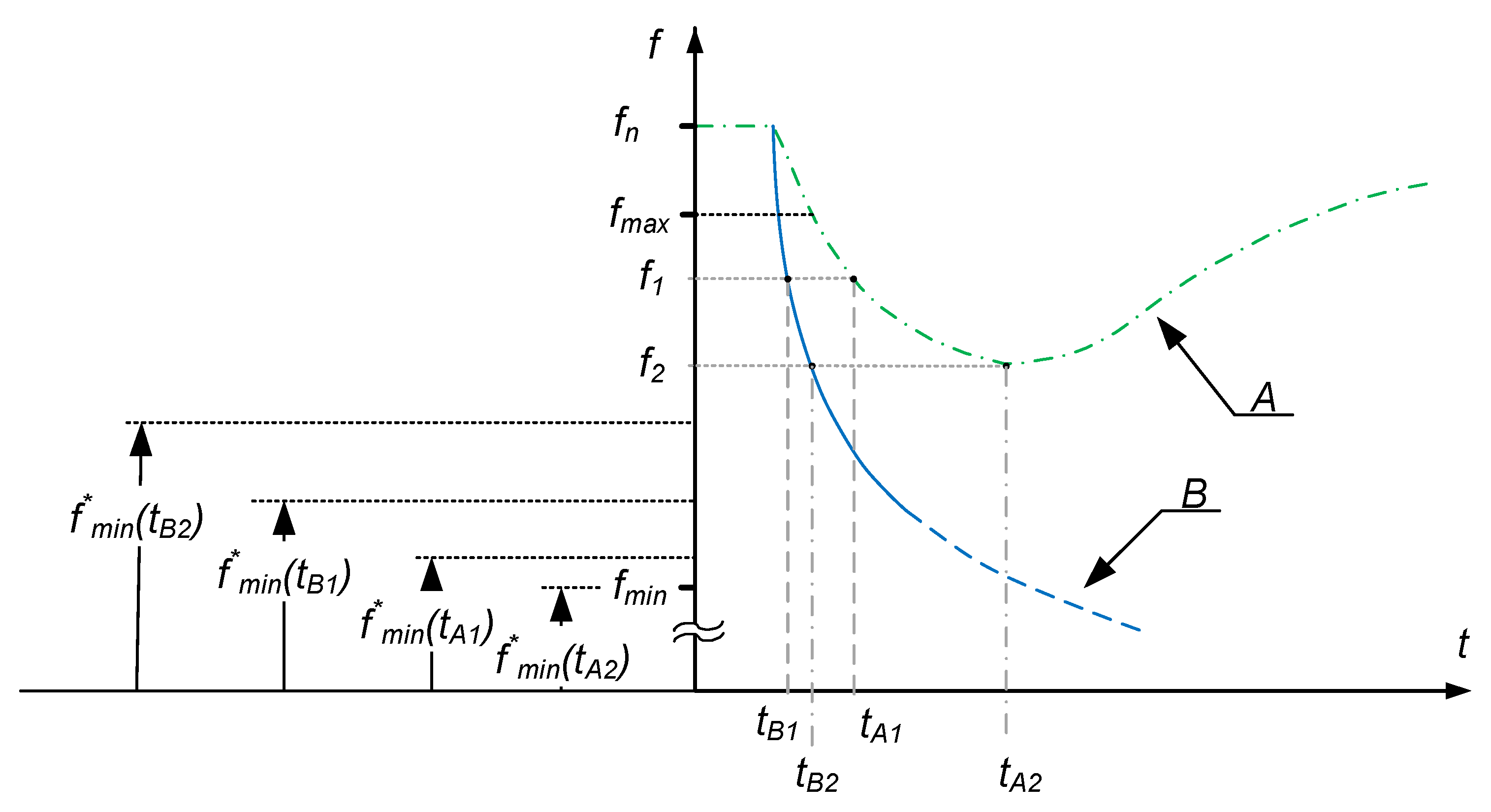
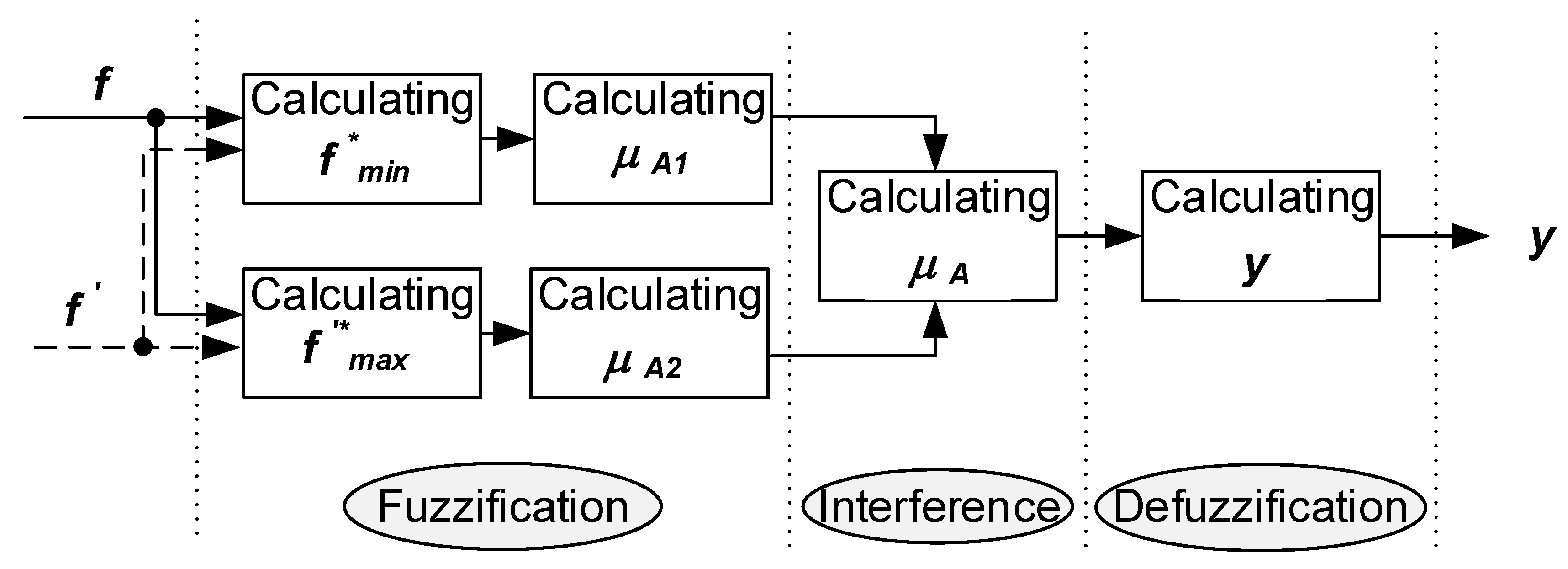
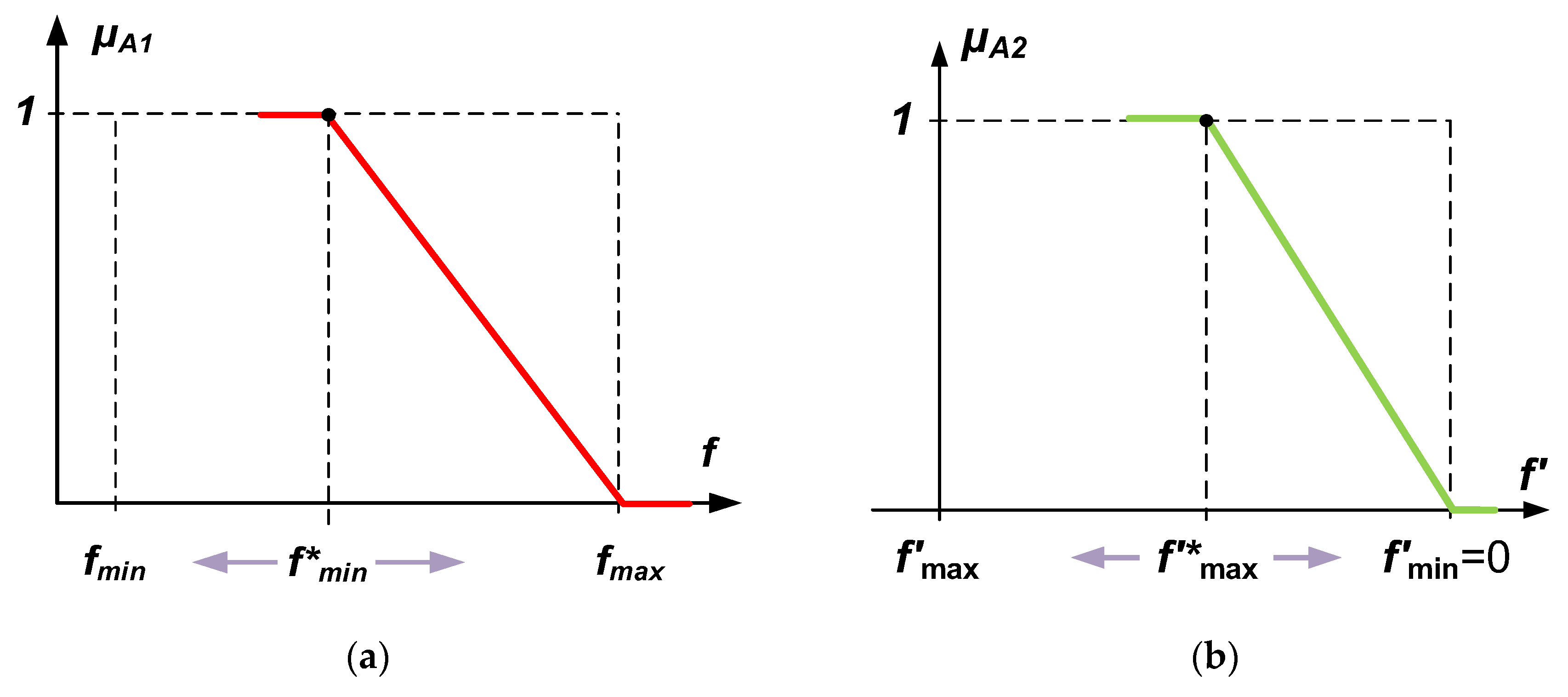
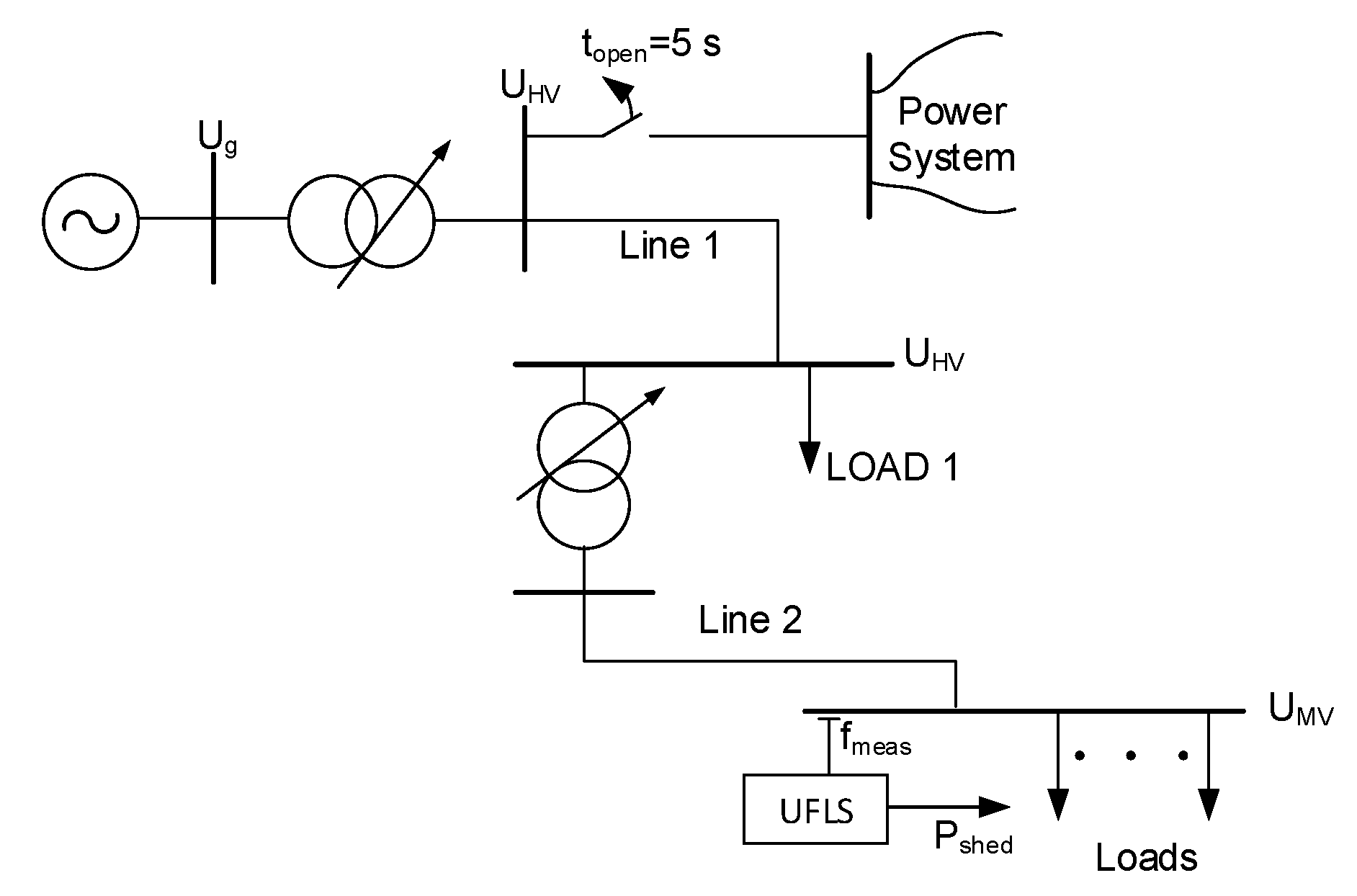
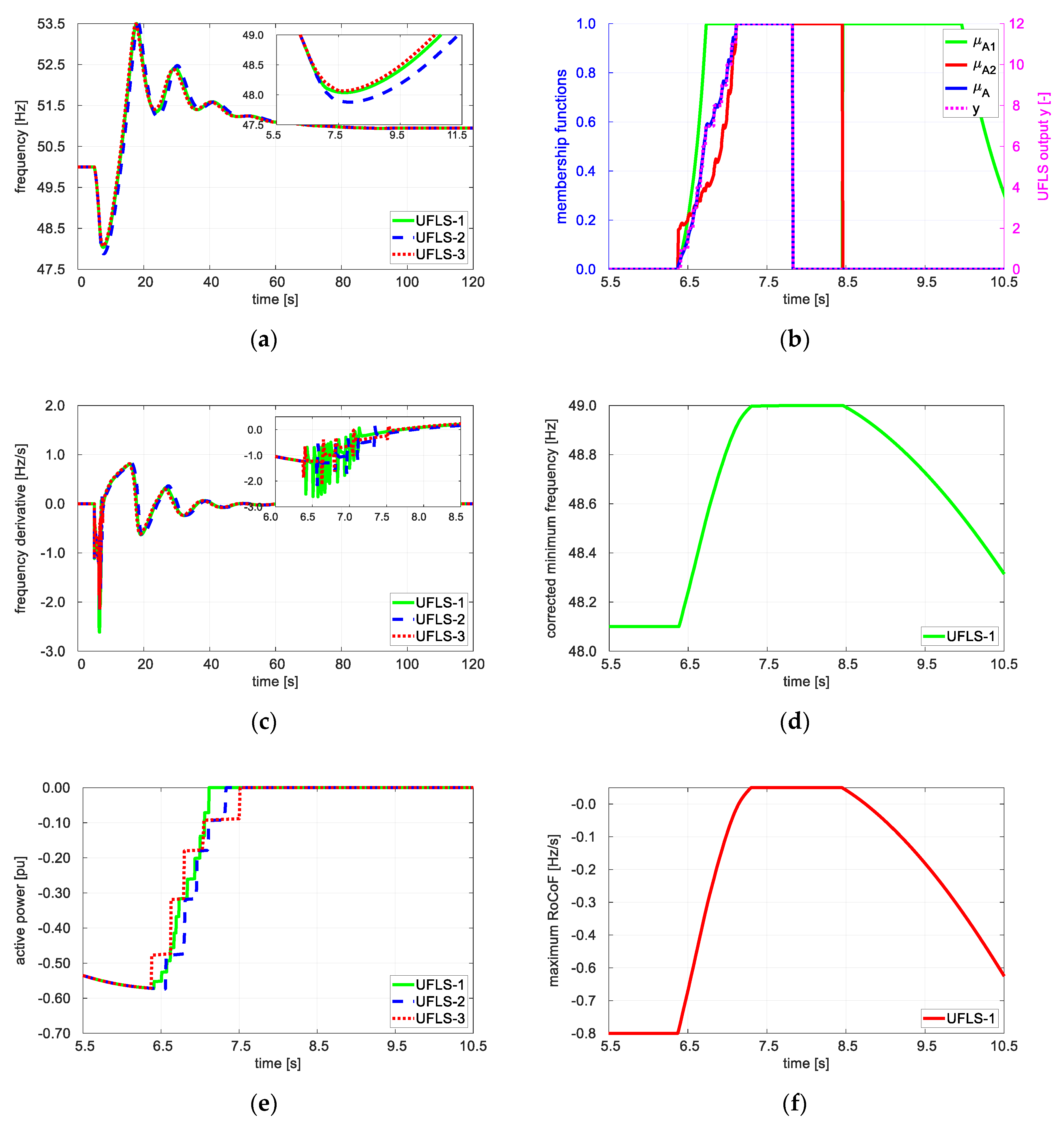
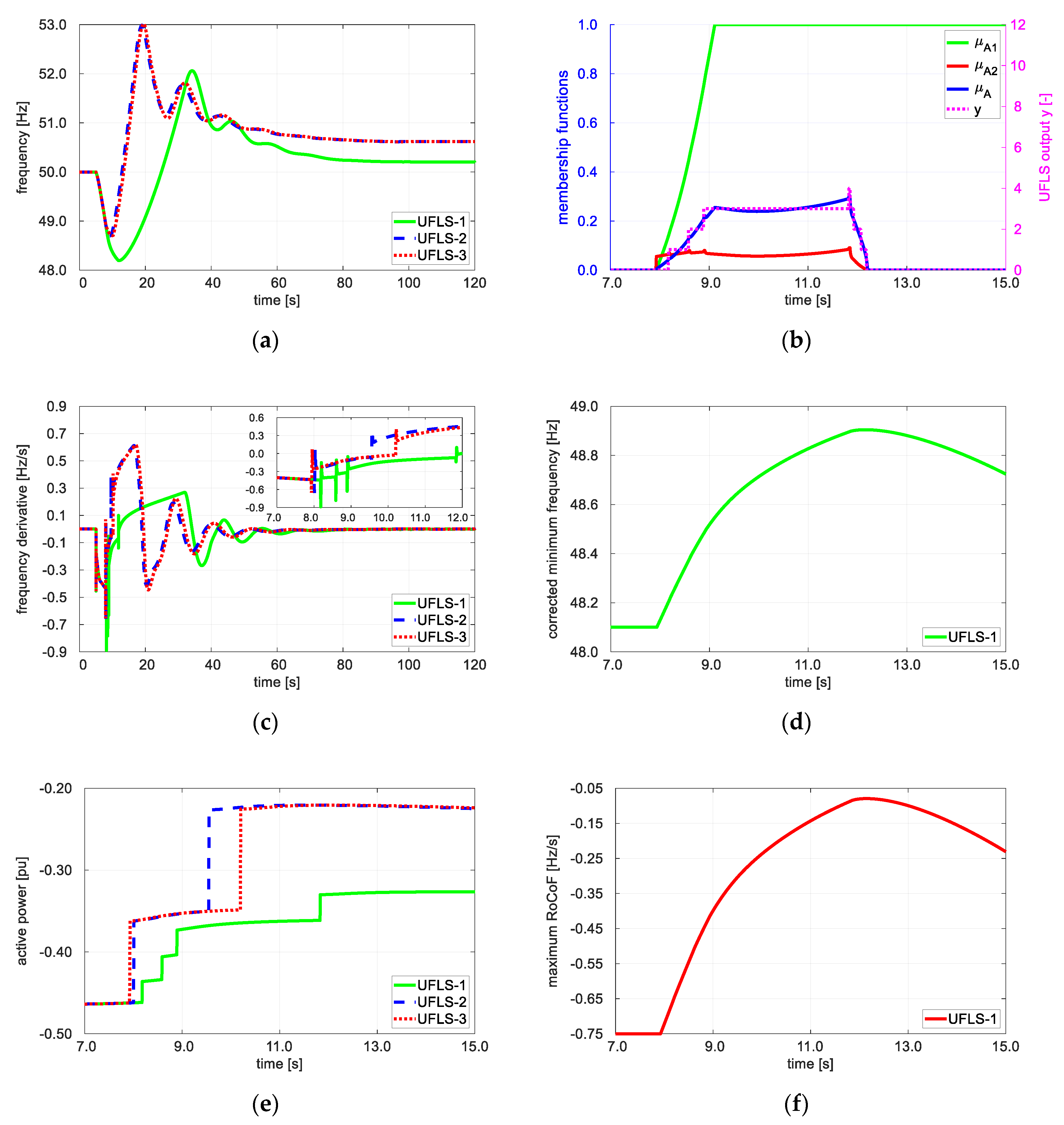
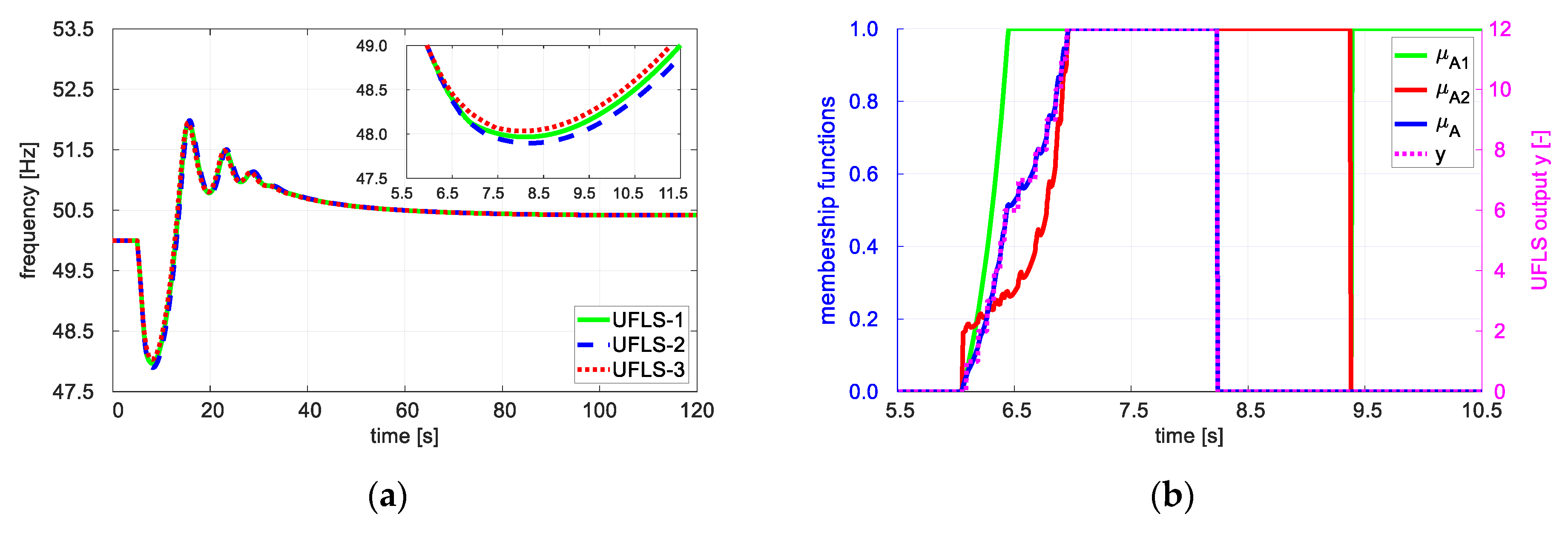


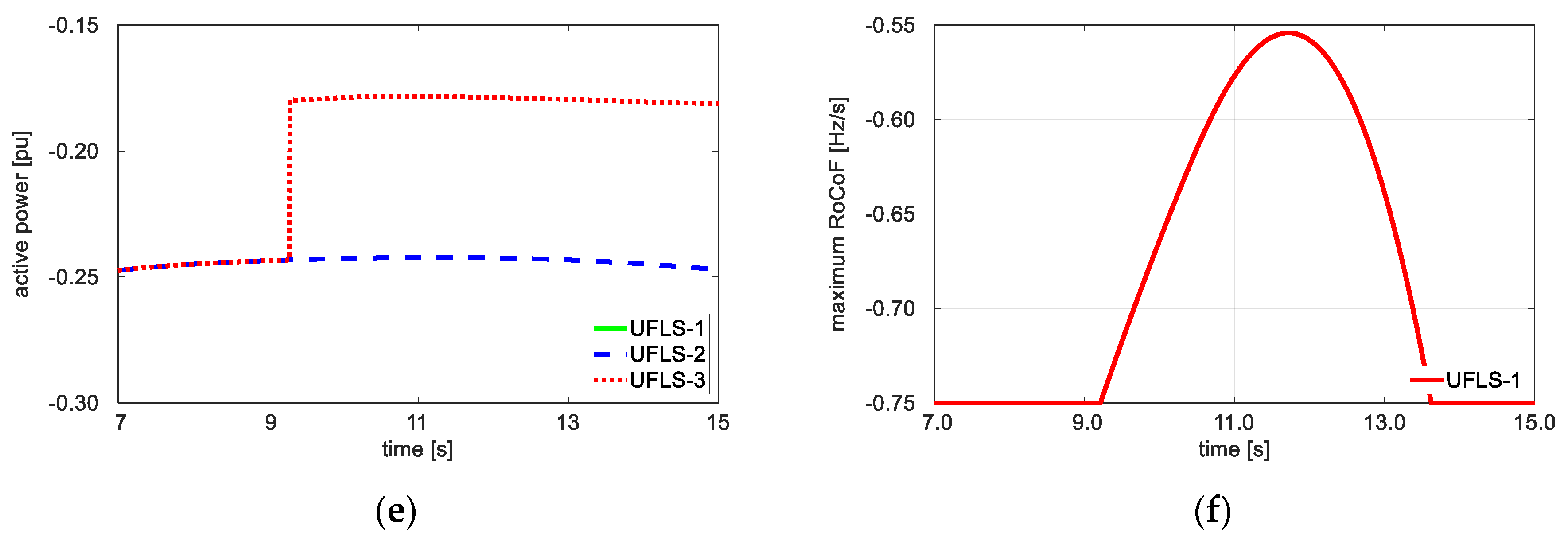
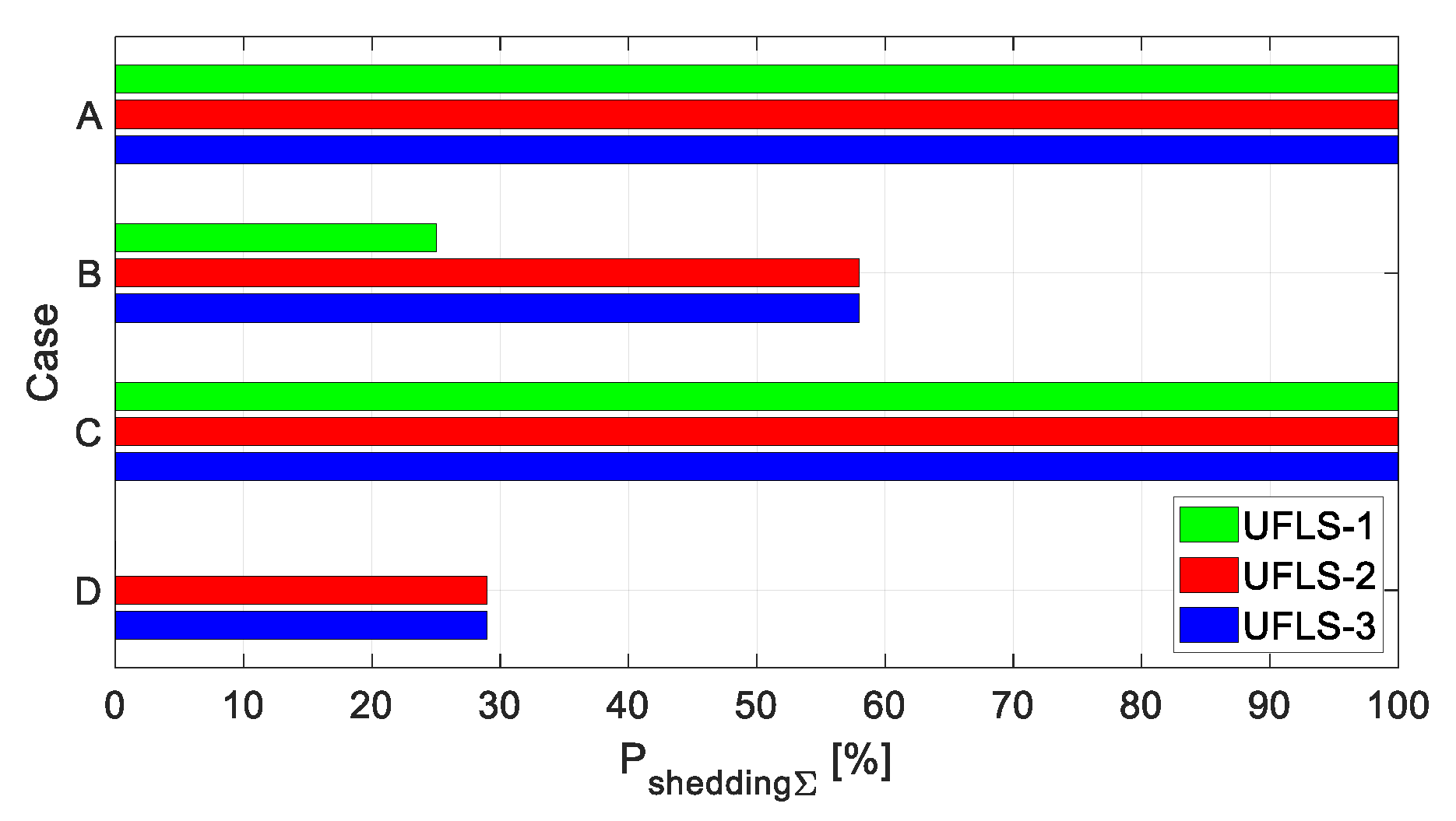
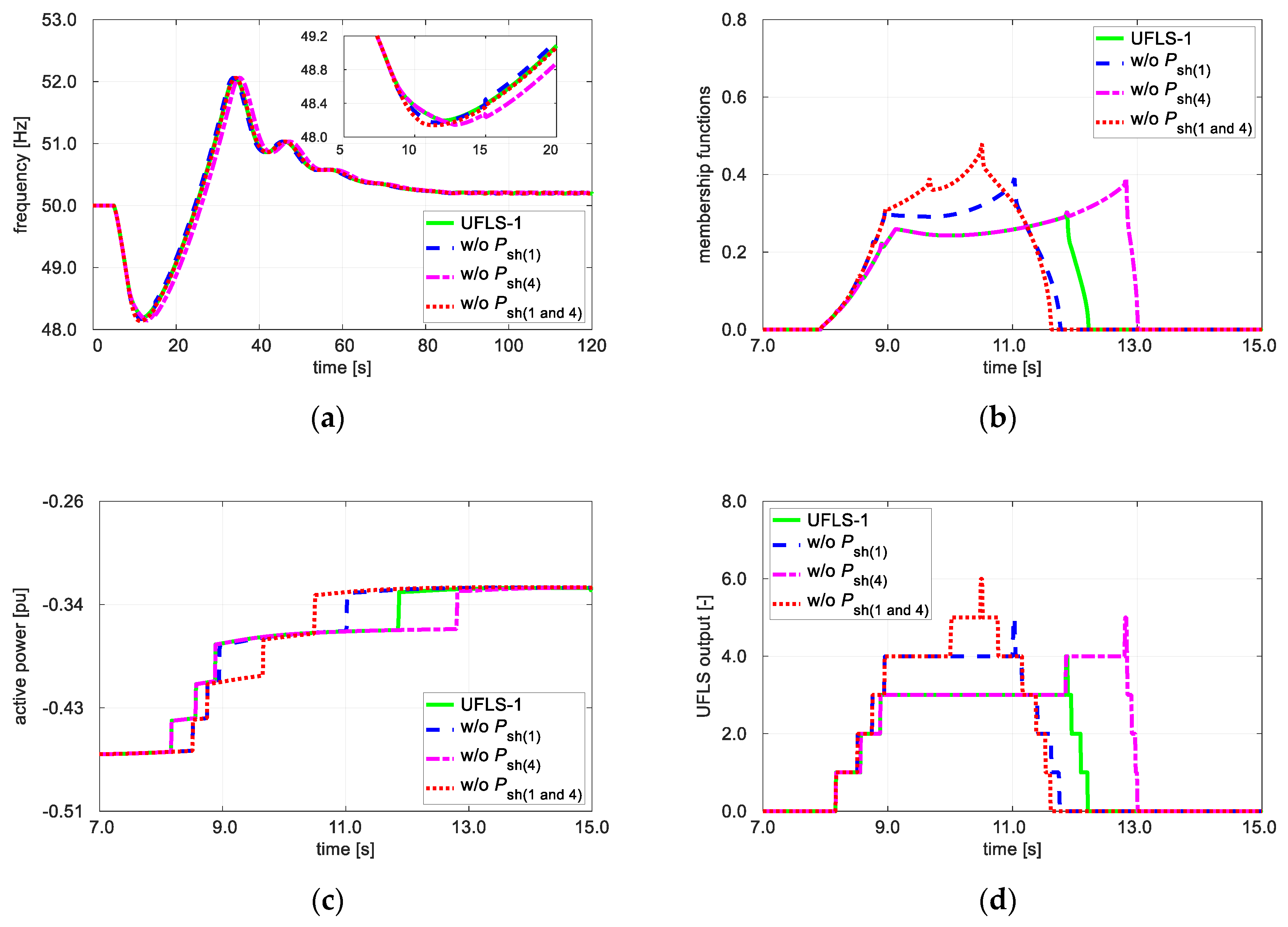
| Stage No. | I | II | III | IV | V |
|---|---|---|---|---|---|
| Psh [%] | 29 | 29 | 20 | 11 | 11 |
| Case | Frequency Derivative |
|---|---|
| A | −1.15 Hz/s |
| B | −0.430 Hz/s |
| C | −1.198 Hz/s |
| D | −0.141 Hz/s |
© 2020 by the authors. Licensee MDPI, Basel, Switzerland. This article is an open access article distributed under the terms and conditions of the Creative Commons Attribution (CC BY) license (http://creativecommons.org/licenses/by/4.0/).
Share and Cite
Małkowski, R.; Nieznański, J. Underfrequency Load Shedding: An Innovative Algorithm Based on Fuzzy Logic. Energies 2020, 13, 1456. https://doi.org/10.3390/en13061456
Małkowski R, Nieznański J. Underfrequency Load Shedding: An Innovative Algorithm Based on Fuzzy Logic. Energies. 2020; 13(6):1456. https://doi.org/10.3390/en13061456
Chicago/Turabian StyleMałkowski, Robert, and Janusz Nieznański. 2020. "Underfrequency Load Shedding: An Innovative Algorithm Based on Fuzzy Logic" Energies 13, no. 6: 1456. https://doi.org/10.3390/en13061456
APA StyleMałkowski, R., & Nieznański, J. (2020). Underfrequency Load Shedding: An Innovative Algorithm Based on Fuzzy Logic. Energies, 13(6), 1456. https://doi.org/10.3390/en13061456






